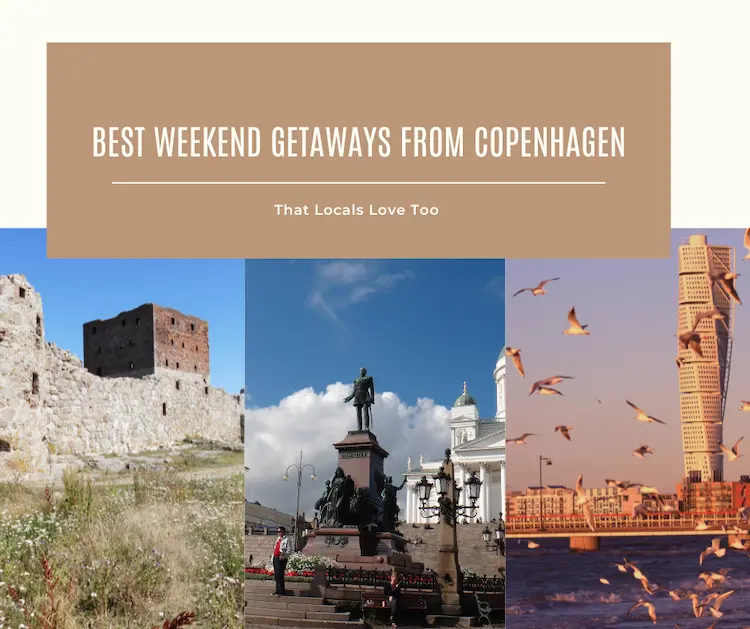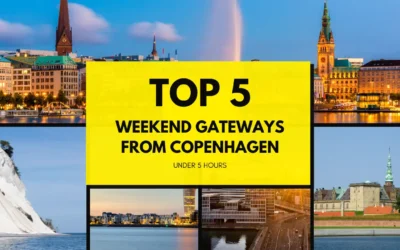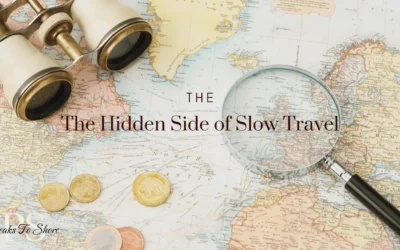Copenhagen captivates with its charming canals, bike-friendly streets, and the cozy hygge vibe that defines Danish life. However, even in such a delightful city, you might occasionally crave a break to exchange urban energy for nature, history, or seaside serenity. Fortunately, Denmark and its neighboring regions are brimming with weekend getaways that locals adore just as much as visitors do. As someone who has explored these spots alongside Danish friends and fellow expats, I’ve uncovered the hidden gems that locals return to year after year. Therefore, in this post, I’ll share the best weekend getaways from Copenhagen—places that Danes love too—complete with travel details, must-do activities, insider tips, and answers to common questions. Whether you’re eager for a cliffside hike, a wine-tasting adventure, or a dip into Nordic culture, these destinations are perfect for a two- or three-day escape. So, let’s get started on this journey!
1. Møns Klint: Nature’s White Cliffs
Why Locals Love It
Møns Klint, featuring dramatic white chalk cliffs plunging into the Baltic Sea, is a local favorite for its awe-inspiring landscapes and tranquil atmosphere. Additionally, Danes flock here for hiking, picnics, and family outings, especially during summer when the cliffs shimmer under the sun and the surrounding forests burst with greenery.
Getting There
Situated on Møn Island, about 130 km southeast of Copenhagen, it’s a 90-minute drive or a 2–2.5-hour journey by public transport. To begin, take a regional train from Copenhagen Central Station to Vordingborg (1 hour), then hop on bus 660 to Stege, followed by bus 667 to Busemarke. From there, it’s a 6 km walk to the cliffs, so consider a taxi for the last leg if you’re not up for the trek. Alternatively, driving is more convenient, with parking available near the GeoCenter Møns Klint.
What to Do
- Hike the Cliffs: The 10 km trail along Møns Klint offers breathtaking views of the sea and cliffs. Moreover, wear sturdy hiking shoes—the paths can be uneven and slippery after rain.
- Visit the GeoCenter: This interactive museum dives into the area’s geology, with fossils and exhibits about the cliffs’ formation (admission ~100 DKK).
- Beach Time: Descend the wooden stairs to the rocky beach below for a swim or to hunt for fossils—locals often find prehistoric treasures here.
- Local Eats: Stop by a café in Stege for fresh seafood, like cod with rye bread, a Danish staple.
Insider Tip
Locals often pack a picnic to enjoy hygge on the cliffs. Therefore, bring a blanket, some Danish rye bread, and a thermos of coffee to watch the sunset—it’s an unforgettable experience.
2. Røsnæs Peninsula: Denmark’s Wine Country
Why Locals Love It
The Røsnæs Peninsula, located on Zealand’s west coast, is Denmark’s budding wine region, surprising many with its cold-climate vineyards. Furthermore, locals love the area for its cycling routes, coastal views, and wine-tasting experiences, making it a trendy weekend escape from Copenhagen’s hustle.
Getting There
It’s 120 km from Copenhagen, about a 90-minute drive or a 2-hour train ride to Kalundborg, followed by a 30-minute bus or taxi to the peninsula. Renting a car gives you flexibility to hop between vineyards—check out rental options on GoMore, a popular Danish car-sharing platform (starting at ~500 DKK/day).
What to Do
- Wine Tasting: Visit Dyrehøj Vineyard, one of Denmark’s largest, for tours and tastings (book ahead, ~200 DKK/person). They produce crisp whites and sparkling wines that locals rave about.
- Cycle the Coast: Rent a bike in Kalundborg and pedal 15 km along scenic paths connecting the vineyards, with views of Kalundborg Fjord.
- Beach Walks: Stroll along the fjord’s shores, where you’ll find wildflower fields and quiet spots for reflection.
Insider Tip
Locals often book a wine-paired lunch at Dyrehøj’s restaurant—it’s a must-do, but reservations fill up fast with Copenhageners on weekends, so plan ahead.
3. Skagen: The Northern Tip
Why Locals Love It
Skagen, at Denmark’s northernmost point, is cherished for its golden beaches, unique light (thanks to the sandbar where two seas meet), and artistic heritage. Likewise, locals visit for summer holidays or quiet winter retreats, drawn by the serene beauty and cultural history.
Getting There
It’s 400 km north, a 5-hour drive with stops, or a 5.5-hour train ride via Aarhus (change at Aalborg). For a scenic route, take the Molslinjen ferry from Aarhus to Odden, then drive or bus to Skagen—check schedules on their site for times and fares.
What to Do
- Grenen Sandbar: Walk to the tip where the Baltic and North Seas collide—bring waterproof boots, as waves can splash over the sandbar.
- Skagens Museum: Explore works by the Skagen Painters, a 19th-century art colony inspired by the area’s light (~100 DKK entry).
- Beach Day: Relax at Skagen Beach or try kite surfing—locals love the windy conditions for water sports.
Insider Tip
Danes often rent summerhouses here for a true local experience. Platforms like Airbnb have options starting at 1,500 DKK/night—book early for summer weekends.
4. Bornholm: The Sunshine Island
Why Locals Love It
Nicknamed “Denmark’s Sunshine Island,” Bornholm is a local gem with rugged cliffs, dense forests, and some of the freshest seafood in the country. Consequently, locals cherish its biking culture and quaint towns, making it a year-round escape for nature lovers.
Getting There
It’s 150 km east, with a 35-minute flight to Rønne (from 300 DKK one-way) or a 3–4-hour trip via train to Ystad, Sweden, then a ferry to Bornholm. Flights are the fastest option, but the ferry offers a scenic journey across the Baltic Sea—check ferry schedules on BornholmerFærgen.
What to Do
- Cycle the Island: Rent a bike in Rønne and explore sites like Hammershus, Denmark’s largest castle ruin (free entry).
- Seafood Feast: Try smoked herring at a traditional smokehouse in Svaneke—locals swear by its smoky flavor.
- Nature Walks: Hike in Almindingen Forest, one of Denmark’s largest woodlands, or relax on Dueodde Beach, known for its fine white sand.
Insider Tip
Locals recommend taking the early morning ferry to avoid crowds. Grab a window seat and a coffee to enjoy the views as you sail to the island.
5. Samsø: Green Living Haven
Why Locals Love It
Samsø is a sustainability pioneer, known for its wind turbines and organic farms. Similarly, locals visit for its serene villages, cycling routes, and eco-focused events like those hosted by the Samsø Energy Academy, making it a refreshing escape.
Getting There
It’s 110 km northwest, a 2.5-hour drive or a 2-hour train to Kalundborg, then a 1-hour ferry to Sælvig (ferry ~200 DKK round-trip). Cars are handy, but you can rent bikes on arrival for a more local experience.
What to Do
- Cycle the Island: Follow the 50 km circular route through fields and villages, with stops at local farms.
- Visit Organic Farms: Tour Brattingsborg for a taste of organic cheese or veggies—locals often buy direct from the source.
- Relax on Beaches: Ballen Strand is a favorite for swimming and picnics.
Insider Tip
Locals love the free guided tours at the Samsø Energy Academy, where you can learn about the island’s green initiatives. Check their website for schedules and book a spot.
6. Helsingør: Hamlet’s Hometown
Why Locals Love It
Helsingør, home to Kronborg Castle (the inspiration for Shakespeare’s Hamlet), charms locals with its maritime history, cozy cafés, and proximity to Sweden. As a result, it’s a quick escape for history buffs and families looking for a cultural day trip.
Getting There
Just 45 km north, it’s a 45-minute train ride from Copenhagen Central Station using the DOT app (~70 DKK one-way). It’s one of the easiest getaways on this list.
What to Do
- Kronborg Castle: Tour the castle’s grand interiors or catch a summer Shakespeare performance (~150 DKK entry).
- Maritime Museum: Explore Denmark’s seafaring history in a stunning building designed by Bjarke Ingels (~110 DKK).
- Stroll the Town: Wander the cobbled streets and stop for a coffee at a local café like Café Brostræde.
Insider Tip
Locals often head to the beach near Kronborg in summer for a quick dip after touring the castle—bring a towel and join them.
7. Gilleleje: Coastal Charm
Why Locals Love It
This fishing village on North Zealand’s Riviera draws locals for its colorful huts, sandy beaches, and fresh fish markets. Consequently, it’s a go-to spot for weekend relaxation or summer festivals like the Gilleleje Fish Festival.
Getting There
It’s 60 km north, a 1-hour drive or a 1.5-hour journey by public transport. Take a train to Hillerød, then the 950R bus to Gilleleje (~100 DKK total). Driving is faster and lets you explore the coast at your own pace.
What to Do
- Beach Time: Swim or sunbathe at Gilleleje Beach, a local hotspot with calm waters.
- Fish Market: Buy smoked salmon or cod straight from the boats—locals line up early for the best picks.
- Hike Nearby: Explore Troldeskoven (Trolls’ Forest), a quirky wooded area with twisted trees and folklore tales.
Insider Tip
Locals recommend arriving early for the fish market—around 8 AM—to get the freshest catch. Pair it with rye bread for a perfect lunch by the sea.
8. Roskilde: Viking History and Music
Why Locals Love It
Roskilde blends Viking heritage with modern culture, hosting the famous Roskilde Festival every summer. Likewise, locals love its cathedral, museums, and relaxed fjordside vibe, making it a versatile getaway.
Getting There
Just 30 km west, it’s a 20-minute train ride from Copenhagen Central Station (~50 DKK). It’s the closest destination on this list, perfect for a quick escape.
What to Do
- Viking Ship Museum: See restored longships and learn about Viking seafaring (~130 DKK entry).
- Roskilde Cathedral: Visit this UNESCO site, the burial place of Danish royalty (free entry).
- Fjord Walk: Stroll along Roskilde Fjord for stunning views and a peaceful escape.
Insider Tip
Locals often time their visits for the Roskilde Festival (late June–early July) for a lively experience, or visit in off-season for quiet fjord walks—check event schedules to plan your trip.
9. Dragør: Quaint Fishing Village
Why Locals Love It
Dragør, with its thatched cottages and 12th-century charm, draws locals for its peaceful streets and summer markets. Therefore, it’s a short escape from Copenhagen, offering a glimpse of old Denmark.
Getting There
It’s 12 km south, a 30-minute bus ride (350S from Tårnby Station, ~30 DKK) or a 45-minute bike ride along the coast. Biking is a popular choice among locals for this quick getaway.
What to Do
- Explore the Village: Wander the colorful streets and visit the Dragør Museum (~50 DKK).
- Beach Walk: Enjoy Amager Strandpark’s sandy shores, perfect for a relaxing stroll.
- Market Day: Check out open-air markets in summer for local crafts and baked goods.
Insider Tip
Locals love biking to Dragør—it’s an easy, scenic ride from Copenhagen. Rent a bike through a service like Baisikeli (starting at ~100 DKK/day) and enjoy the coastal route.
10. Malmö, Sweden: Cross-Border Adventure
Why Locals Love It
Just across the Øresund Bridge, Malmö offers a taste of Swedish culture, affordable dining, and beautiful parks. Consequently, Danes visit for a quick change of scenery, often combining it with duty-free shopping on the ferry.
Getting There
It’s 40 km away, a 35-minute train ride from Copenhagen Central to Malmö Central (~120 DKK one-way). Alternatively, take the DFDS ferry for a scenic trip—check schedules on their site.
What to Do
- Turning Torso: Admire this twisting skyscraper from the waterfront, a modern architectural marvel.
- Gamla Staden: Explore the old town’s cobblestone streets, lined with quaint shops and cafés.
- Food Scene: Try Swedish meatballs at a local spot like Stortorget—more affordable than Copenhagen dining.
Insider Tip
Locals often take the DFDS ferry for a scenic round-trip (~300 DKK) and to stock up on duty-free goods. It’s a fun way to experience the Øresund crossing.
Planning Your Getaway
Travel Tips
- Transport Options: Trains and buses are reliable—use the DOT app for tickets and schedules. Renting a car (e.g., via GoMore) offers flexibility for destinations like Røsnæs or Bornholm.
- Best Time to Visit: Spring (April–June) and summer (July–August) are ideal for outdoor activities like hiking, cycling, and beach trips, with long daylight hours. Alternatively, fall (September–October) offers cozy vibes and fewer crowds.
- What to Pack: Bring layers, as Danish weather can change quickly, plus comfy shoes for hiking or cycling, and a reusable water bottle—Danes value eco-friendly travel.
- Budget: Expect to spend 1,000–2,000 DKK for a weekend, covering transport, food, activities, and a basic guesthouse stay.
Sustainable Travel
Follow local practices to travel sustainably: use public transport, support local businesses like farm shops or small cafés, and leave no trace. Because Denmark prides itself on sustainability, joining in helps preserve these beautiful destinations.
FAQs
What’s the easiest weekend getaway from Copenhagen?
The easiest getaway is Roskilde, just a 20-minute train ride away. It’s perfect for a quick day trip or overnight stay, with attractions like the Viking Ship Museum and Roskilde Cathedral. Similarly, Dragør is another close option, reachable by a 30-minute bus ride or a 45-minute bike ride.
Are these getaways suitable for families?
Yes, most destinations are family-friendly. Helsingør offers Kronborg Castle with kid-friendly tours, while Samsø and Gilleleje have calm beaches and nature activities. Likewise, Bornholm’s cycling routes and Skagen’s sandbar are hits with families—just ensure younger kids have proper gear for biking or hiking.
How much should I budget for a weekend trip?
A weekend getaway typically costs 1,000–2,000 DKK per person, depending on your travel style. This includes round-trip transport (50–300 DKK), meals (200–400 DKK), activities (100–300 DKK), and a basic guesthouse or Airbnb (500–1,000 DKK/night). Destinations like Malmö or Roskilde are cheaper, while Bornholm or Skagen may cost more due to ferries or longer travel.
Can I visit these places without a car?
Absolutely! Denmark’s public transport is excellent. Trains and buses connect Copenhagen to all these destinations—use the DOT app to plan your route. For islands like Bornholm or Samsø, ferries are part of the journey, and you can rent bikes or walk once you arrive. However, a car is handy for remote spots like Røsnæs Peninsula.
What’s the best time of year for a weekend getaway?
Spring (April–June) and summer (July–August) are ideal for outdoor activities like hiking, cycling, and beach trips, with long daylight hours. Moreover, fall (September–October) offers cooler weather, fewer crowds, and beautiful autumn foliage, especially in places like Almindingen Forest on Bornholm. Winter trips can be cozy, especially in Skagen or Malmö, but pack for cold, windy weather.
Are these destinations good for solo travelers?
Yes, all these getaways are safe and welcoming for solo travelers. Denmark ranks 5th on the 2024 Global Peace Index, so you can explore with confidence. Places like Møns Klint and Samsø offer solo-friendly activities like hiking and cycling, while Malmö and Roskilde have vibrant social scenes for meeting others. Furthermore, join a guided tour or stay at a guesthouse to connect with locals and fellow travelers.
Copenhagen’s weekend getaways are a treasure trove of experiences, blending nature, culture, and relaxation in destinations that locals hold dear. Having joined locals on these trips, I can say they’re as magical as they sound. Which getaway are you most excited to try? Pack your bags, grab a friend (or go solo!), and discover why these spots are beloved by locals and visitors alike. Share your plans in the comments—I’d love to hear where you’re headed next!
For more travel inspiration, check out my guide on living in Denmark: 10 Surprising Rules You’ll Face Living in Denmark.







0 Comments